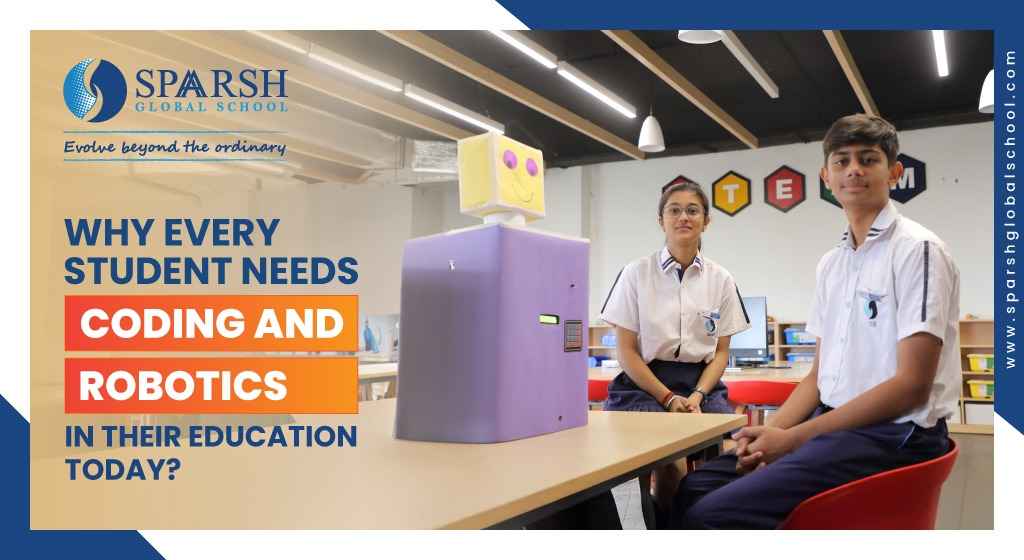The emergence of subjects like coding and robotics has brought about a paradigm shift in the way learning happens. Technological integration is now a key element in schools and emerging subjects like coding and robotics are finding their way in everyday school life.

The Importance of Coding and Robotics in Education
1. Enhancing Problem-Solving Skills
Students must use critical thinking along with analytic abilities while they learn coding and robotics. The process of robot construction and programming enables students to develop both logical reasoning and computational thinking abilities. Through their learning experience, students develop critical thinking abilities which transform complex problems into smaller workable elements to find systematic solutions. Activities involving game and robot design enable students to develop troubleshooting skills that help them optimise processes that apply to various real-world scenarios.
2. Encouraging Creativity and Innovation
Through robotics education, students find opportunities to display their creative abilities. Programming tools enable students to build interactive digital applications together with games as well as develop operational robots that produce specific machine functions. Students develop innovative solutions when participating in these activities since they have to move past standard approaches to create distinct projects. Through their creativity, students learn to become techno-inventors and problem-solving experts who help create the technological developments of tomorrow.
3. Building Confidence and Resilience
The process of learning coding and robotics provides students with one of their most important life lessons about perseverance. Students need both patience and resilience for successful debugging and robotic mechanism improvements. During their coding experiences, students develop a growth mindset because they encounter hurdles that teach them that failure leads to achievement. Through this experience, students build their confidence as their productive work results in operational projects. This builds self-assurance.
4. Developing Collaboration and Teamwork
Students must collaborate throughout the entire process of creating coding structures when building robotics systems during design programming and testing phases. Teamwork together with communication and leadership are learnt while students explain their thoughts, while they listen to their peer’s ideas. Such educational experiences help students become ready for professional workplaces that thrive on collaborative work for creating innovation and achieving success.
5. Preparing for Future Careers
Technology training has become essential for employment since businesses operate in rapidly changing environments. Based on current industry trends, software development together with artificial intelligence and data science and robotics engineering will see massive growth. Educational institutions that teach coding and robotics early provide students an advantage to grab forthcoming opportunities. Students who learn programming fundamentals and automation basics through School in Greater Noida West gain an advantage that helps them succeed in any profession, including healthcare and finance, even when they choose nontechnical careers.
6. Enhancing Digital Literacy
Students require digital fluency in our current technology-driven world. Their transition from digital content consumers to innovative technology creators allows students to explore new ways of using technology through actively manipulating digital tools. Their increased understanding will enable students to make responsible and ethical decisions while using digital resources including cybersecurity, data privacy management and digital communication behavior.
Implementing Coding and Robotics in Schools
The integration of these subjects at an early education stage becomes necessary for providing every student with coding and robotics benefits. Schools can achieve this by:
- Teaching coding to primary students through programming languages Scratch and Python, which are suitable for their age level.
- Educational experiences where they conduct robotics activities with their own hands.
- Create coding clubs together with competitions to let students excel in their programming capabilities beyond normal lessons.
By working together with technology firms and educational organisations, schools can give students direct experience with real-world coding and robotic applications.
Conclusion
Students who study coding and robotics from an early age develop problem-solving abilities as well as creative competencies and perseverance. They acquire skills required for future career paths in a technology-dominated society. By embracing coding and robotics, schools empower students to become innovators, critical thinkers and leaders in the digital age.
At Sparsh Global School, a strong emphasis is placed on equipping students with 21st-century skills through a forward-thinking curriculum that includes coding and robotics. Through its innovative learning approaches Sparsh Global School invests in creating future leaders who will drive innovation.
FAQ
1. What resources are needed for schools to implement coding and robotics programmes?
Schools need age-appropriate programming software, robotics kits, trained educators and access to technology like computers and tablets to create an engaging learning environment.




